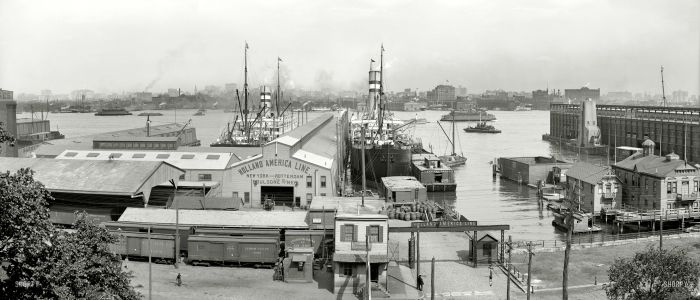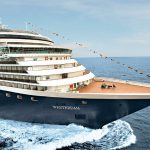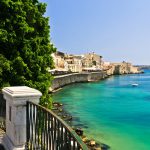We recently came across some photos of the port of Hoboken, N.J., from about 1910, when it was the North American headquarters of Holland America Line.
The photo below shows the SS Potsdam, built in 1900, which sailed between Rotterdam and Hoboken for 15 years. (If you zoom in on the photo, you may be able to see the Cunard Line docks, just across the Hudson River in New York City.)

Hoboken Then
At the time these photos were taken, the southern portion of Hoboken’s waterfront was dominated by cruise ship piers. The northern portion was dominated by the delicious smell of roasting coffee, being home to a major production plant for Maxwell House Coffee, as well as Lipton Tea and dry dock facilities for Bethlehem Shipbuilding.
These photos are all the more valuable because they were taken not long before Hoboken’s time as a cruise ship port came to an end. During World War I, the city’s piers became a major port of embarkation for soldiers; more than three million passed through on their way to the front. After the war, Hoboken’s waterfront became more industrial, and the cruise ships did not return.

By the 1970s, Hoboken’s shipping docks has become obsolete, and most of the waterfront was simply abandoned – a big change from the days when excited passengers, dressed in their best, boarded cruise ships bound for Europe and beyond.
Hoboken Now
Today, you’ll find Hoboken’s waterfront has renewed itself again. The old warehouses and dry docks, along with musty taverns and boarding houses, have been razed. Some of the old buildings have been renovated for different uses, helping to preserve the city’s history and architectural heritage. For example, the Lipton Tea building is still there, enjoying a new life as a luxury condominium building.
In fact, the Hoboken waterfront is now a mainly residential area. Apartments and condominiums offer wonderful views of the Hudson River and the shimmering city of New York. At street level, you’ll find bistros, coffee houses, pubs, boutiques and galleries. You can stroll along the waterfront on a riverbank promenade, too.
The redevelopment of Hoboken’s waterfront has attracted commuters from New York, as well as artists, musicians, restauranteurs and others who appreciate the proximity to New York and the character of Hoboken itself.
A Pre-Cruise Gem
While Hoboken is no longer a cruise ship port, it’s a lovely place to spend some time before you board your ship at Cape Liberty cruise port in Bayonne – about eight miles to the south – or at the Manhattan Cruise Terminal or the Brooklyn Cruise Terminal.
Hoboken is a major commuter transportation hub, so it’s easy to reach by rail line or ferry from many other parts of the New York metro area. In fact, it’s worth the trip just to see the beautiful, Beaux-Arts style Hoboken Terminal, decorated with Tiffany stained glass and Greek Revival motifs.
We want to mention that Hoboken isn’t the only former port to fall into disuse: in fact, it’s in good company. London, England, was once an important international port, but its location on the River Thames puts it at a disadvantage in the modern, large-ship era of cruising and shipping.
Cruise ships ports are always evolving, and new ones are emerging, too.



